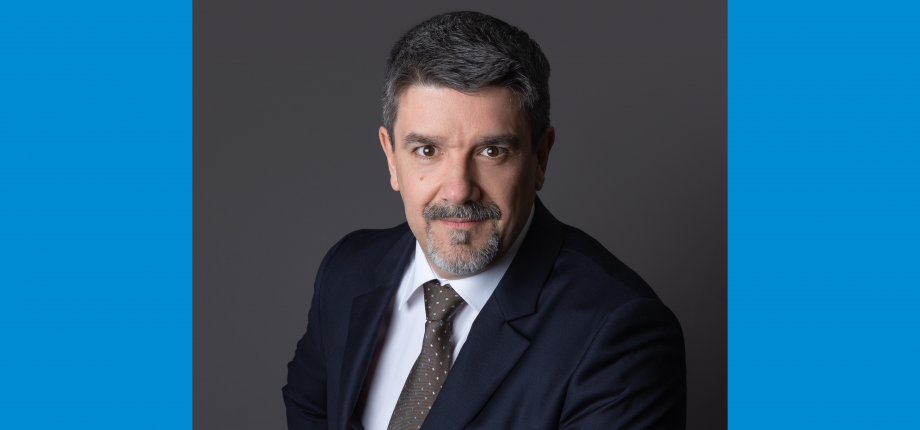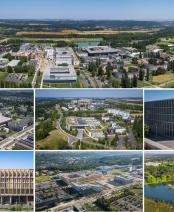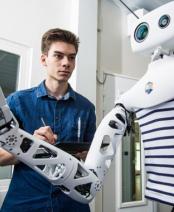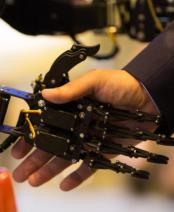Interview with François Mathieu, technical director of the Apollon laser infrastructure

The 16th of May, declared by UNESCO as the International Day of Light, is celebrated each year because it is the anniversary of the first successful operation of the laser in 1960 by the physicist Theodore Maiman. Since the 16th of May, 1960, science has made great progress in this field. Today, the laser, which remains a scientific instrument, has many applications in everyday life (reading CDs, bar codes, surgery, cutting and welding in industry, etc.). You work at the Laboratory for the Use of Intense Lasers (LULI*). How does your laboratory contribute to the progress of science?
Our laboratory is specialized in the study of plasmas created by high-power lasers and their applications. Our main missions are research in plasma physics, the provision of high-power lasers and facilities to researchers, training in plasma physics, high-power lasers and optics.
We design lasers, create facilities for scientists who are looking for applications, so that they can conduct experiments. We accompany researchers and we are pushed by them to create new things; more powerful, more compact, more reliable lasers. With each experiment, we progress. As a result, there are two kinds of applications that come out: either the applications that users have imagined, or the applications that result from what we have managed to do with the lasers. Let's say 60% of our users already have an idea in mind of civilian applications they are looking for. These are researchers working in the fields of astrophysics, material studies, radiography, etc. So, we can say that the LULI does not manage direct applications, but participates, with other laboratories, in their development.
We work a lot with the laser industry. In addition, we develop measuring devices to control the parameters of lasers. This type of equipment can be used in other fields, not only in plasma physics.
You mentioned training. How does LULI contribute to higher education and training?
Our laboratory is very involved in the training of young people. The environment is favourable here, we are surrounded by schools and universities, which are also our supervisors. Every year we welcome apprentices, interns and PhD students. Many of our researchers teach in master's programs. I have taught courses in M2, and this has enabled me to attract good people for my team. In addition, the LULI, with 6 other IP Paris laboratories, is the carrier of the PLASMAScience Graduate School, initiative financed by the PIA 3, whose objective is to enrich the teaching in plasma physics and to attract the best students in internships, masters and PhD programs.
The LULI is the operator of Apollon[1], a facility that has one of the most powerful lasers in the world. You are the technical director of this research infrastructure. Tell us about this flagship project of the LULI. How was this project born?
The story began in 2006. The idea, driven by Gérard Mourou, was to design a multi-petawatt laser based on the Chirped Pulse Amplification (CPA) technique. This technique earned Gérard Mourou the Nobel Prize in Physics in 2018. Then a reflection was conducted within the Applied Optics Laboratory (LOA[2]), the LULI and the Institut d'Optique Graduate School. The project was really launched at the beginning of 2009 with seven supervisory bodies: the École Polytechnique, the CEA, the CNRS, the ENSTA Paris, the IOGS, the University of Paris Sorbonne and the University of Paris-Saclay. Having several supervisors has its advantages, because they bring different things to the table. For example, the CNRS provides human and financial resources, the X provides human resources and premises, etc.
So, the objective was to create a very powerful laser?
The objective was to create a research infrastructure with very high-power lasers (up to 10 Petawatts) to explore new areas of ultra-relativistic physics, vacuum physics and plasma physics.
Thanks to Apollon, we are able to study matter in the femtosecond regime (10-15 or one millionth of a billionth of a second). We can capture the movement of particles, for example photograph the movement of an electron around the nucleus in plasmas. This was not possible with lasers of the previous nanoseconds’ generations (10-9, or one billionth of a second) or picoseconds’ generations (10-12 or one millionth of a millionth of a second).
Apollon will be open to teams of researchers from around the world who will be able to work, for example, on particle acceleration and X-rays and develop their applications in the fields of energy, biology, medicine and nuclear energy.
And why this name, Apollon? Is it related to the Greek god of music, arts and male beauty, carrying bows and arrows?
Yes, this Research Infrastructure is named after this Greek god because Apollon is also the god of light! Some people think that Apollon is an acronym (the use of acronyms is very common in the scientific field). I am often asked what the A, the P, the O etc. mean. I explain that it is not an acronym, but the name of the Greek god.
Apollon has received a lot of press coverage since its launch. What is its situation today? Is the Research Infrastructure open to users?
The Research Infrastructure is still under construction. We are supposed to have several beams: a one Petawatt beam and a ten Petawatt beam. The first one is working, researchers from the CNRS, the IP Paris, the CEA and the Paris-Saclay University have carried out experiments. A total of 3 experimental campaigns have already been carried out. The ten Petawatt one will be finished next year.
The project was launched in 2009. The realization of the project took more than 12 years...
Yes, but we started almost from scratch. At first, we had to look for a location, because the place we had initially planned was not quite suitable. Finally, we found a building in l'Orme des Merisiers (the Saclay Plateau) and we did some renovation work (8 million euros). We preferred this option, which was less expensive and quicker, to the construction of a new building, which would have taken longer and cost about 40 million euros. So we saved time and money.
After that, there were other challenges. In particular, the integration of the equipment. For some subjects, we started with theses. Also, obtaining certain components was not obvious and took longer than expected. Then, since March 2020, with the Covid it is complicated for everyone and my team, which is quite young (thirty-year-olds with children), is not an exception.
It is true that we are behind schedule, but the priority was not on the planning. It was about getting the performance and staying within the budget. The goal was to make a 10 Petawatt laser, and if it took longer, it didn't matter, as long as the budget was respected. In the end, we were within budget, because there was less than 10% difference between what was planned and what was spent.
Are there other similar lasers in the world? There is a lot of talk about the Apollon exception. What makes it so exceptional?
Yes, there are similar installations in Eastern Europe, implemented as part of the European Extreme Light Infrastructure project in Romania, Hungary and the Czech Republic. However, we have many differences and it is not necessarily a question of power.
If we take only the lasers, the installation in Romania is the one that resembles us the most. It is almost a "copy and paste" of our laser, since our know-how has been transferred to the company Thales, which has set up this installation there.
On the other hand, since the applications sought are not the same, the experimental rooms are not designed in the same way. For example, here we have a "long focal area" where the laser travels a long way. The Romanian facility is not equipped with such a room.
As for Hungary, its laser has a higher rate (600 shots every minute (10 hertz)), but with much less energy. The applications are very different. What is sought here are attoseconds ((10-18 s), which is the smallest unit of time to have been measured.
The infrastructure in the Czech Republic is similar to us in terms of its offer and proposes the same type of experiments. However, they are not the same lasers. It is equipped with American and UK lasers. Also, the difference in equipment will be based on the existence of our second room, the "Short Focal Area”, which offers great versatility in the configuration of the two beams arriving in the experimental chambers.
Do you mean that Apollon groups together and offers different techniques, which is not the case for the mentioned infrastructures in Eastern Europe?
Yes, it can be said that we have no equivalent in Eastern Europe. Our real competitors are in Asia. There is, for example, an infrastructure in Korea, and I have had very good feedback from users who have tested it.
However, here we have a great advantage over other facilities: we know how to receive external teams. And that's a real skill. For at least 30 years, the LULI has been hosting researchers from all over the world. At the LULI there are those who make lasers and those who use lasers. When an experiment is organized, there is always someone from the LULI who participates, who knows the machine well and who knows how to get the best out of it. In addition, we have the possibility to configure the machine, to change the parameters according to the users' requests.
The infrastructures I mentioned work differently. For example, in the Czech Republic, people know how to operate their infrastructure very well, but they are not yet used to work with other users, to setting up an experiment with outside researchers. The facility in Korea has produced few scientific publications to date, which tells me that they do not have the same stimulating environment that we have here on the Plateau de Saclay. The scientists, our users, know how to use lasers and will push us to make the machine evolve and thus keep our attractiveness.
To conclude, I can say that if we take the intrinsic machine, our competitors are in Korea. But if we take the machine with all its possibilities and its environment, today we have no competitors. There will be a whole population of researchers who will prefer to come and do manipulations with us.
Apollon is addressed to researchers. Will students be able to benefit from this top-level facility?
Apollon participates directly and indirectly in the training of young people. On the one hand, under normal conditions, we regularly try to welcome young engineers (apprentices, M1 and M2 trainees, PhD students). Unfortunately, at the moment, because of the pandemic situation, we have to limit the number of people and it is difficult to welcome students. On the other hand, when researchers come to do experiments, they are often accompanied by their PhD students.
Do you think that plasmas are the future?
Certainly. The primary application of plasmas is the study of matter and materials. A better understanding of matter and materials allows us to better use and conserve them.
Let's take the example of wind turbines. Today, everyone agrees on the benefits of green energy. However, the cost of maintenance represents a real obstacle to their implementation. If we manage, for example, to create laser-hardened materials, there will be less damage, maintenance will be less expensive, which will encourage manufacturers to make more wind turbines.
When I talk about materials, it can be mineral or living. For example, LULI researchers contribute to the medical field, working on proton therapy, a radiotherapy technique aimed at destroying cancerous cells by irradiating them with a beam of particles (the protons are generated by the laser). Compared to "conventional" radiotherapy, proton therapy makes it possible to better target tumors and destroy them while minimizing damage to healthy surrounding tissue. Today this technique is considered as a treatment of the future.
When we think of the future, we inevitably think of space exploration, life on Mars etc. Do you know that several devices in the space field use plasmas? Let's take for example "Perseverance", this small robot landed on Mars last February. This rover is equipped with a laser manufactured by Thales. It's a pity that we don't communicate more internationally about this laser "made in France". This laser is used to study the matter and the composition of the ground. The laser is able to create plasma, by heating soil samples up to 10,000°C and vaporizing them. This method, called Plasma Optical Emission Spectrometry, can determine the chemical composition from the light emission of the plasma.
As you can see, plasmas are used in many forward-looking sectors. The study of plasmas allows us to work on matter, to transform it, to improve it. There are many perspectives and many things to do!













